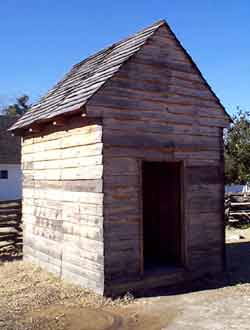Page content
Peyton Randolph Storage Building

The Peyton Randolph Storage Building was the second building completed on the Randolph property. It is the simplest of the buildings constructed to date. The Storage Building is approximately six feet wide and 10 feet long and efforts were made to give the appearance of a building partially constructed from reused timbers. As a result, there is a mixture of materials used in the construction of the Storage Building. Oak, poplar and long-leaf yellow pine can all be found in the frame of the building. A close examination might reveal phantom joints that appear to have been cut for use in previous buldings. The Storage Building was sided and roofed with riven (split) oak clapboards. The door, door trim, and flooring were constructed from reused long-leaf yellow pine.
Photos of the various steps in the process of the construction of the Randolph Storage Building.

Carpenters raised the last frame of the building season on New Year's Eve 1997. It's an 8' x 10' storage building that 18th-century Virginians called a \"lumberhouse\"
By spring 1998 the lumberhouse is entirely covered with clapboards.
The storage building is located at the rear of the Randolph property. It is not visible from the house. If this clapboard building seems too rustic for the city of Williamsburg, then consider the way that most 18th-century Virginians lived.
If this structure were twice as big with windows and a chimney, then most 18th-century citizens would have been happy to call it home. With its brick foundation and wooden floor, this lumberhouse is nicer than many 18th-century homes
The clapboard siding is cut at the corners to provide a tight fit and better protection from the elements.
Don't let the light fool you, the clapboard roof provides plenty of protection from the elements.
The framing of the lumber house is simply riven (split) material, or material recycled from previous buildings.
